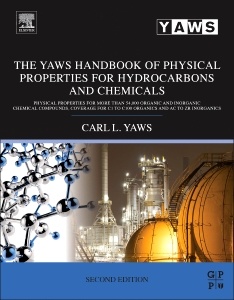Description
The Yaws Handbook of Physical Properties for Hydrocarbons and Chemicals (2nd Ed.)
Physical Properties for More Than 54,000 Organic and Inorganic Chemical Compounds, Coverage for C1 to C100 Organics and Ac to Zr Inorganics
Author: Yaws Carl L.
Language: English
Subjects for The Yaws Handbook of Physical Properties for...:
832 p. · 21.4x27.6 cm · Hardback
Description
/li>Contents
/li>Biography
/li>Comment
/li>
Refineries and petrochemical engineers today are accepting more unconventional feedstocks such as heavy oil and shale, causing unique challenges on the processing side of the business. To create more reliable engineering design of process equipment for the petrochemical industry, petroleum engineers and process managers are forced to study the physical properties and compounds of these particular hydrocarbons. Instead of looking up each compound?s information, The Yaws Handbook of Physical Properties for Hydrocarbons and Chemicals, Second Edition presents an easy-to-use format with rapid access to search for the particular compound and understand all the complex calculations in one tabular format. Understanding the composition of hydrocarbons is not easy to calculate quickly or accurately, but this must-have reference leads the engineer to better estimated properties and fractions from easily measured components. Expanded to cover more total compounds and relevant functions, The Yaws Handbook of Physical Properties for Hydrocarbons and Chemicals, Second Editionremains a necessary reference tool for every petrochemical and petroleum engineers? library.
1. Physical Properties – Organic Compounds 2. Physical Properties – Inorganic Compounds3. Properties – Water4. Properties – Air
- Coverage added on elements for hydrocarbons and chemicals with more than 200 real-world cases included for practicality
- Increased compound coverage from 41,000 to 54,000 total compounds to quickly access for everyday use
- New functions added such as testing boiling point temperature and new data on density and refractory index



